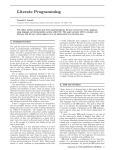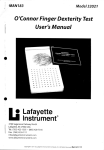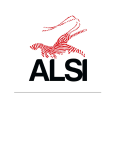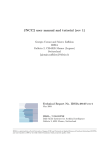Download user manual.
Transcript
JNCC Report No. 514 Supplemental Paper Further development of a spatial framework for mapping ecosystem services User Manual Medcalf, K., Small, N., Finch, C., Williams, J., Blair, T., Haines-Young, R., Potschin, M. & Parker, J. March 2014 © JNCC, Peterborough 2014 ISSN 0963 8901 For further information please contact: Joint Nature Conservation Committee Monkstone House City Road Peterborough PE1 1JY http://jncc.defra.gov.uk This report should be cited as: Medcalf, K., Small, N., Finch, C., Williams, J., Blair, T., Haines-Young, R., Potschin, M. & Parker, J. 2014. Further development of a spatial framework for mapping ecosystem services - User Manual. JNCC Report, No. 514 Supplemental Paper, JNCC, Peterborough. Contents 1 Background .................................................................................................................... 4 1.1 Who is the User Manual for? ............................................................................. 4 1.2 Ecosystem approach .......................................................................................... 4 1.3 Approach ............................................................................................................. 4 1.4 Producing ecosystem service maps ................................................................. 6 2 Data - how to obtain it and assess whether it is fit for purpose for ecosystem services mapping.................................................................................................................. 7 2.1 Data audit ............................................................................................................. 7 2.1.1 Data collection ............................................................................................ 7 2.1.2 Data suitability considerations .................................................................... 8 2.2 Considerations of scale ..................................................................................... 9 2.2.1 Supply and demand ................................................................................... 9 2.2.2 Mapping and data scale ............................................................................. 9 2.3 Consideration for rule development ............................................................... 10 2.4 Using a GIS to produce ecosystem service maps ......................................... 11 2.4.1 Modelling techniques ............................................................................... 11 2.4.2 Mapping validation ................................................................................... 11 2.4.3 Data certainty ........................................................................................... 12 3 Spatial framework ecosystem service database ...................................................... 13 3.1 Background to the spatial database ............................................................... 13 3.1.1 Rationale .................................................................................................. 13 3.1.2 Ecosystem service classifications ............................................................ 14 3.1.3 Ecosystem services ................................................................................. 14 3.2 How to use the database .................................................................................. 15 3.2.1 3.2.2 3.2.3 3.2.4 4 Stage 1: User selects the ‘option’ they require ......................................... 15 Stage 2: Filling in the requested form for the selected option .................. 16 Stage 3 ..................................................................................................... 18 Stage 4 ..................................................................................................... 18 Next Steps .................................................................................................................... 22 4.1 Database development ..................................................................................... 22 4.2 Incorporation with Bayesian Belief Networks ................................................ 22 Further development of a spatial framework for mapping ecosystem services - User manual 1 Background 1.1 Who is the User Manual for? This manual has been prepared for users who want to: • • • understand how to map ecosystem services with the data they have; know what data to use to map an ecosystem service; and understand what effect different scales of data will have when mapping ecosystem services. It has two key purposes, namely: • • demonstrating linkages between habitat classification systems and ecosystem services to be modelled; and providing a framework database which can show: o o 1.2 what it is possible to map for a particular ecosystem service; and what data options are available to map ecosystem services. Ecosystem approach The ecosystems approach strongly focuses on the holistic and integrated management of land, water and living resources to promote conservation and sustainable use. It is a framework which can be used to look at whole ecosystems during the decision making process, and for valuing the ecosystem services (ES) they provide, ensuring that society can maintain a healthy and resilient natural environment for current and future generations. 1.3 Approach This work further developed approaches set out in an earlier JNCC project ‘Spatial framework for assessing evidence needs for operational ecosystem approaches’1 which looked at mapping ecosystem services using existing datasets to model natural resources. The project formed part of a toolkit to facilitate understanding of the linkage between biophysical characteristics and ecosystem services (Box 1). This earlier work examined two habitats in detail, setting out the level of certainty with which the ecosystem services associated to each of these habitats can be mapped. This project involved further analysis of the mapping and modelling of ecosystem services drawing on recently completed practical data driven projects.2 The mapping approach discussed in this document involves utilising a rule base approach to combine and map multiple thematic layers to display the spatial variance in potential ecosystem service provision. The key concepts underpinning this project and previous work are summarised in Figure 1. 1 MEDCALF, K. A., SMALL, N., FINCH, C., & PARKER, J., 2012. Spatial framework for assessing evidence needs for operational ecosystem approaches. JNCC Report No 469. 2 SMALL, N., MEDCALF, K. A., 2013. Galloway and Southern Ayrshire Biosphere ecosystem services mapping project: Technical Summary. Report to Scottish Natural Heritage and Southern Uplands Partnership. 4 Further development of a spatial framework for mapping ecosystem services - User manual Box 1. What the Spatial Framework approach seeks to achieve The ‘spatial framework approach’ contributes to a broader objective of facilitating users to: • describe the biophysical characteristics occurring within a landscape; • make links between the physical and biological characteristics of habitats and the major ecosystems services being provided; • identify practical and appropriate ways in which habitat (and other biodiversity) data can be used to identify and understand ecosystem service provision; • identify ways in which habitat data can be used to describe landscape characteristics and understand how these characteristics vary spatially; and • understand how the condition of habitats and the way they are managed impacts on ecosystem service delivery in different landscape contexts. Ecosystem services link the functions of the environment to all the goods obtained from the environment, both those that are immediately obvious in terms of their value (such as the provision of food crop) and the more hidden value (such as the mitigation of climate change by the binding up of carbon within soil and vegetation). Behind the rationale of this work is the basic premise that each parcel of land influences the delivery of many ecosystem services in some way, even if this contribution is only small (or has a negative effect on that service). These services are intrinsically linked to the habitats/land-cover present on any area of land and further influenced by the key factors of the landform, soil/geology and management of the area. Understanding how each block of land provides these services is an important step into taking informed choices about the management of any block of land. Figure 1. Four key factors to consider during ecosystem service mapping. 5 Further development of a spatial framework for mapping ecosystem services - User manual The approach adopted in this project recognises that whilst this is a young science with many unknowns, there is a large body of data already available which can be used to inform the development of scientific rules to underpin ecosystem service mapping. 1.4 Producing ecosystem service maps Every part of the earth’s surface provides not just direct benefits such as food and timber or a building plot, but also indirect benefits such as the regulation of water flow to prevent flooding and the storage of carbon in the soil which will help mitigate the effects of climate change. Ecosystem service mapping needs to capture, and reflect as far as possible, the underlying functional processes and properties. The spatial framework project considers the background to and concepts underlying a range of ecosystem mapping techniques. The mapping approach adopted during the project works by using knowledge of natural systems to categorise: • the importance of a dataset (that can be used for mapping) to the particular ecosystem services being mapped. To understand natural processes fully we need up-to-date accurate information on the state of natural systems. Even with less than ideal data and a less than exact knowledge about the interactions between a habitat, its location, management and the associated ecosystem service, it is possible to grade the importance into a simple categorisation. As research progresses and new data sets are developed it will be possible to further refine these classifications. The spatial framework project also considers how different terminologies (such as ecosystem service classification systems) are used to describe these services and how these terminologies relate to each other. Intrinsic to such an assessment is the need to understand: • how different habitat mapping systems relate to each other and how they relate to the different ecosystem services the land provides; and • how the different ways of classifying plant communities allows different types of ecosystem service maps to be developed. Biophysical features ‘above’ and ‘below’ ground are important in driving the level of ecosystem service provided. To assist users with their mapping applications, the study sought to: • identify the sort of data that is available to map the seven most often mapped ecosystem services; • examine how the scale of data is related to the precision that it is possible to achieve when describing the ecosystem service features on the ground; and • describe how the scientific literature supports the modelling of services based on current scientific environmental knowledge. The mapped outputs from the case studies are a useful resource to help inform land use decisions because they form part of the evidence base to back up an ecosystem approach having considered environmental, economic and cultural aspects of the UK’s natural heritage. 6 Further development of a spatial framework for mapping ecosystem services - User manual 2 Data - how to obtain it and assess whether it is fit for purpose for ecosystem services mapping 2.1 Data audit A data audit for mapping ecosystem services comprises two key stages, a data collection exercise and assessment of ‘fitness-for-purpose’ of the data collected (the spatial assessment). 2.1.1 Data collection A key stage when conducting an ecosystem service mapping study is to obtain a selection of suitable datasets which can be used as indicators to represent services spatially. There are a number of data providers who make available a good range of candidate datasets (Table 1). Table 1. Data providers and associated sources of data for ecosystem services mapping. Data Providers Organisation Website name Weblink Scottish Natural Heritage Natural Spaces https://gateway.snh.gov.uk/natural-spaces/index.jsp Natural England Data http://www.naturalengland.org.uk/publications/data/ Environment Agency Geo store http://www.geostore.com/environment-agency/ Ordnance Survey Open Data http://www.ordnancesurvey.co.uk/business-andgovernment/products/opendata-products.html English Heritage Designation data http://www.englishheritage.org.uk/professional/protection/process/spatial-data/ Historic Scotland GIS downloads http://data.historic-scotland.gov.uk/pls/htmldb/f?p=2100:10:0 Forestry Commission Data download http://www.forestry.gov.uk/datadownload Data references and online map viewer MAGIC Dataset listings and download options http://www.magic.gov.uk/Dataset_Download_Summary.htm During the data collection phase users may collect a variety of data types to include in the suitability assessment, for example, tabular, spatial or numerical. Each of these data types can be manipulated to be included within a spatial framework. To ensure a sound foundation for mapping, the spatial framework approach suggests that as a minimum users collect data and information on each of the four key influencing factors (habitat, soil/geology, landscape and management - see Figure 1). Table 2 suggests datasets that the study team consider to be ‘exemplar’ data in relation to the four key factors. 7 Further development of a spatial framework for mapping ecosystem services - User manual Table 2. Sources of high quality datasets for the four key influencing factors. Factor Data theme Habitat type Habitat Data Name Phase 1 Habitat Survey Land Cover Map 2007 Substrate type Landscape context Management and socioeconomic influences Source Natural Resources Wales Centre for Hydrology and Ecology (CEH) BAP Priority Habitats Natural England Geology DiGMap-250 British Geological Survey Soils NATMAPVector Cranfield University Elevation Terrain 5 Ordnance Survey Landform Panorama Ordnance Survey NEXTMAP Britain GETMAPPING Forestry Commission Estate recreation routes Forestry Commission Country parks Natural England Cycle routes Sustrans Integrated Habitat System Somerset Environmental Records Centre Crop data Bespoke Recreation Land use Water abstraction Development Housing Environment Agency Local authorities Availability Under restricted licence Payable licence applicable Open government licence Payable licence applicable Payable licence applicable Payable licence applicable OS open data/ Open government licence Payable licence applicable Open government licence Open government licence Under restricted licence Payable licence applicable Bespoke terms and conditions may apply Under restricted licence Under restricted licence During this stage, it is good practice to record details about the data, perhaps in the form of a data log so that all users have access to a baseline record document which can be used as a key reference (e.g. that provides details on data sources, licence types, data contacts, precision and accuracy of the data). This will ensure all knowledge about the data is captured and can subsequently be kept up to date to reflect changes or further work being carried out. 2.1.2 Data suitability considerations Mapping uses spatial datasets, including both point and polygon vector data and raster data, collected at a variety of different scales, at different dates and with a variety of accuracies and resolutions. The quality of the ecosystem service mapping will to a large extent be as good as the data that has been fed into the analysis and the supporting rule-base created. Following the data collection stage, all data should be subjected to a suitability and appropriateness assessment to address the question ‘is it fit-for-purpose?’ The ‘data log’ document can be used to record the details from the suitability assessment. 8 Further development of a spatial framework for mapping ecosystem services - User manual Key factors the user should consider are: • • • • • • • Quality (in terms of coverage, topology and projections). Suitability (whether appropriate information is included within the layer). Precision and accuracy information. Availability and licensing (PSMA licensing, Open Government Licensing, under restricted licence, payable licence applies etc.). Metadata quality is an important component of identifying data. Attached metadata explains to the end user how the data was captured, the limitations of the data and the confidence within the information provided. Caution should be applied for those datasets which are not provided with sufficient accompanying information. The age of the dataset and how frequently an update is made. Geographical variability of datasets e.g. 50m digital terrain map (DTM) would be suitable in a high terrain environment (e.g. Snowdonia National Park) but would not be suitable to capture the subtle differences in elevation in areas like Norfolk. It will become apparent that for any individual ecosystem service, there is no one single dataset that is readily available, appropriate to use, simple to map and fully representative of that service. 2.2 Considerations of scale 2.2.1 Supply and demand Scale is an important overarching factor to consider when mapping ecosystem services. Natural systems have intrinsic scales of operation, differing across space and time. Moreover, the services being supplied are available at a range of ecological scales whereby there is often a mismatch between point of provision and the location it is being received3 4 5 (i.e. where the demand is). Mapping is a useful tool for illustrating the spatial mismatch between the provision and the demand of the service under examination6. 2.2.2 Mapping and data scale Data must be fit for purpose; broad scale data is most suitable for use at a national, strategic level to inform national policy and planning issues at this scale. At a local level, broad scale data could potentially over simplify the context and does not often include the detail needed if used in isolation at a local scale. To overcome this, broad scale data can be used if highly detailed local data on environmental and social assets can be nested in to reflect the situation. However, the subsequent analysis must be conducted at the resolution of the broadest scale dataset. Previous studies have shown that regulating and provisioning services are often mapped at larger scales7. This is often because data resolution dictates 3 HAUCK, J., GÖRG, C., VARJOPURO, R., RATAMAKI, O., MAES, J., WITTMER, H., JAX, K., 2013. Maps have an air of authority: Potential benefits and challenges of ecosystem service maps at different levels of decision making. Ecosystem Services, 4: 25-32. 4 HEIN, L., VAN KOOPEN, K., DE GROOT, R.S., VAN IERLAND, E.C., 2006. Spatial scales, stakeholders and the valuation of ecosystem services, Ecological economics, 21: 39-53 5 PAGELLA, T., 2011. Review of spatial assessment tools for the mapping of ecosystem services. Report 3/11, Bangor: Wales Environment Research Hub. 6 CROSSMAN, N, D., BURKHARD, B., NEDKOV, S., WILLEMEN, L., PETZ, K., PALOMO, I., DRAKOU, E, G., MARTIN-LOPEZ, B., MCPHEARSON, T., BOYANOVA, K., ALKEMEDE, R., EGOH, B., DUNBAR, M, B., MAES, J., 2013. A blueprint for mapping and modelling ecosystem services, Ecosystem Services, 4: 4-14. 7 EGOH, B., DRAKOU, E.G., DUNBAR, M.B., MAES, J., WILLEMEN, L., 2012. Indicators for mapping ecosystem services: a review. Report EUR 25456 EN. Publications Office of the European Union, Luxembourg. 9 Further development of a spatial framework for mapping ecosystem services - User manual the scale of ecosystem mapping. Local proximal8 and site specific service types, such as pollination, demand higher resolution data, which may not be available. As a consequence, these services might be mapped less frequently (and therefore poorly represented in decision making scenarios) due to the absence of this data and the high uncertainty that surrounds the mapping if lower resolution data is used. Different scale levels of policy and decision making have different requirements (as well as different uses) of spatial information9. Ecosystem services are fluid and have no fixed boundaries and therefore do not neatly fit within operational spatial scales. Mapping ecosystem services is a constantly evolving arena. When further research and data becomes available then the mapping models can be updated by utilising this new knowledge. 2.3 Consideration for rule development Using a rule base approach to combine and map multiple thematic layers to display the spatial variance in potential ecosystem service provision provides a stepped approach to building a representation of the whole or part of a complex ecosystem interaction. It takes account of: • • • the specific attribute information of each dataset considered important for mapping that service; the relative value to be assigned to each element to enable mapping; and if applicable, details on weightings required when different datasets are to be combined. The characteristics of ecosystems can be represented to an extent by the attribute information available within the spatial datasets. Current scientific knowledge on the ecological attributes identified to underpin ecosystem services can be linked to measurable attributes within the datasets. A simple mapping classification using values high, moderate, low, neutral and negative can be used to split the datasets up for each ecosystem service being mapped. These values represent the effect that attribute has on the delivery of the ecosystem service being examined. For example, for soil carbon storage, a peat soil would be scored ‘high’ in terms of potential soil carbon richness. Whereby a mineral soil, would be given a ‘low score’. The rule bases developed are designed to be transferable and they integrate scientific knowledge and expert interpretation. Because the rule base is an expert system using both scientific literature and local knowledge the method is iterative in nature (i.e. the rule-base is revisited and improved upon). Local knowledge input is essential to check that the mapping and the in situ characteristics match. This could not be done using scientific principles in isolation. 8 Services which depend on the co-location of the ecosystem providing the service and those who receive the benefit. 9 HAUCK, J., GÖRG, C., VARJOPURO, R., RATAMAKI, O., MAES, J., WITTMER, H., & JAX, K., 2013. Maps have an air of authority: Potential benefits and challenges of ecosystem service maps at different levels of decision making, Ecosystem Services, 4: 25-32. 10 Further development of a spatial framework for mapping ecosystem services - User manual 2.4 Using a GIS to produce ecosystem service maps 2.4.1 Modelling techniques Overlay analysis is a well-established method available in the GIS toolkit which involves intersecting a series of thematic layers to create new spatial units whose properties depend on the combination of factors used to create them (i.e. the input layers of data). Often existing GIS data sets do not occur at the same scale of mapping or have the same area of coverage each having been created for its own particular purpose. In order to overcome this, raster overlay analysis is often utilised. Each dataset (data layer) is turned into a ‘grid’ data set called a ‘continuous raster dataset’ and each individual grid square (pixel) within it is given a data value. These raster maps can be used to derive a new data layer based on combinations of the properties of a series of input layers. Raster grids can be varied in size to accommodate different dataset scales whilst maintaining consistency of mapping (Figure 2). It is the combinations of values which determine the overall spatial variation of importance for the service provided. Figure 2. Varying raster grids to accommodate different dataset scales. Overlay methods have been widely used to produce land suitability maps of different kinds. Their popularity mainly rests on the fact that by relying on ‘standard’ GIS functionality, they are easy to implement, and easy to understand especially by the non-specialist. The methods available vary considerably in their sophistication, from simple Boolean overlay through to more complex ‘map algebra’ techniques, involving combining data layers using weights and/or mathematical functions. Using map algebra, for example, the strength of influence of the different input data layers can be varied. 2.4.2 Mapping validation Verifying the data values assigned and producing the subsequent maps is an iterative process. The rule-base and mapping exercise should be inclusive and involve stakeholders, utilising their local knowledge. Validation by stakeholders is crucial and production of these maps cannot be done in isolation. 11 Further development of a spatial framework for mapping ecosystem services - User manual 2.4.3 Data certainty The maps of ecosystem services are a modelled approximation of our best estimate of the situation at the current time with the data available. The certainty behind the mapping is dependent on the quality of the information which has fed into the models development, both scientific knowledge and spatial detail. The user should utilise data which is appropriate to the scale of the analysis. Any proposed actions on sites below the initial mapping scale (e.g. individual sites) will need to be assessed at a site level through other means e.g. environmental impact assessment. If individual sites surveys are undertaken the results should be fed back into the rule base to help enhance the spatial accuracy of the map. 12 Further development of a spatial framework for mapping ecosystem services - User manual 3 Spatial framework ecosystem service database This section of the user guide summarises the key stages in operating the JNCC spatial framework database. 3.1 Background to the spatial database To encourage discussion and to progress the Framework approach, the project team produced a ‘structure’ for a decision framework, which is supported by a database. It helps the user to understand what ecosystem services are mapable, at what scale, and using which data. The ecosystems spatial framework database was built using a customised Microsoft Access 2010 database. This customised interface allows users, unfamiliar with MS Access, to easily interact with the information and generate reports (Figure 3). This customisation was achieved using ‘MS Access forms’, which limits the user’s interaction with the raw database to a few simple buttons and selection boxes. The forms are driven by several background tables that are used in conjunction with SQL queries and VBA scripts. These are used to create the selections and allow the user to navigate the database. For example, when the user clicks the report button for Options 1 and 2 (Figure 5) MS Access reports are created then saved to a location selected by the user. For Option 3, the rule base considerations report relating to the selected service is copied to a location selected by the user. Figure 3. Customised user interface of the database. 3.1.1 Rationale The rationale behind the development of a spatial framework database was to start bringing together the large body of data already available and demonstrate how these datasets could be used to inform the development of scientific rules to underpin an ecosystem services inventory and to facilitate the mapping process. 13 Further development of a spatial framework for mapping ecosystem services - User manual 3.1.2 Ecosystem service classifications There are a number of different ecosystem service classifications in use, so the spatial framework database uses the Common International Classification of Ecosystem Services (CICES) as a pivotal classification to which the UKNEA, MA and TEEB classifications can be referenced too. CICES was developed to overcome the problems of multiple classifications and to understand the correspondence between them10. Within the database there is a translation table which translates the CICES classification to UKNEA, TEEB or MA (Figure 4). CICES is a classification of final ecosystem services, which are defined as the biotic ecosystem outputs that are directly used or consumed by people. It uses a hierarchical structure and Figure 3 illustrates what the CICES class ‘Flood protection’ (bottom left hand side) translates to in other ecosystem service classifications (orange box on right hand side). Figure 4. Spatial Framework ‘translation’ table showing TEEB, MA and NEA equivalents for the CICES class ‘Flood Protection’. If the user first selects Regulation and Maintenance’ in the ‘Section’ (broader category) in the CICES box, followed by the option ‘Mediation of Flows in the ‘Division’, then the option ‘liquid flows’ from the more defined types of service under the ‘Group’ heading this identifies the ‘Class’ Flood Protection, which when selected translates to ‘hazard regulation’ under the UKNEA and so forth (in the orange box). 3.1.3 Ecosystem services The database allows the user to explore seven ecosystem services which were chosen from the ecosystem service mapping review (discussed in section 2.2 of the final report) and from two other recent literature reviews11 12. At this stage, the database does not include an exhaustive list of ecosystem services. However, with further development the database can accommodate more ecosystem services and data suggestions. 10 HAINES-YOUNG, R. & POTSCHIN, M., 2013. Common International Classification of Ecosystem Services (CICES). Report to the European Environment Agency (download: www.cices.eu). 11 MARTI´NEZ-HARMS, M.J.,& BALVANERA,P., 2012. Methods for mapping ecosystem service supply: a review. International Journal of Biodiversity Science , Ecosystem Services & Management, 8: 17–25. 12 EGOH, B., DRAKOU, E.G., DUNBAR, M.B., MAES, J., & WILLEMEN, L., 2012. Indicators for mapping ecosystem services: a review. Report EUR 25456 EN. Publications Office of the European Union, Luxembourg. 14 Further development of a spatial framework for mapping ecosystem services - User manual 3.2 How to use the database The database takes into account the main factors and the logical steps that need to be followed in a process that should facilitate and inform mapping of ecosystem services. Each of these factors is discussed in more detail in this section. The database takes into account the scale of the project that the user is considering and the data available in terms of habitat, soil, geology, landform and management. The data lists included in the database are not by any means an exhaustive list. The data listed are those which are familiar to the project team, some of which the project team have experience in utilising in an ecosystem service mapping project. There are four stages to follow when using the options within the database: • • • • • Stage 1: The user selects the ‘option’ they require from the main splash screen. Stage 2: The user fills in the requested form for their selected option. Stage 3: The database processes the selection to create an output or inform the user that no output can be created from their selection. Stage 4: The reports are saved. Stage 5: Depending on whether option 1 or 2 has been selected, the user then can move onto option 3. 3.2.1 Stage 1: User selects the ‘option’ they require The user selects either option 1 or option 2 depending on whether they have data available or not (Figure 5). Following their selection of option 1 or 2 they carry on to option 3. Figure 3. Layout of the main database splash screen showing the options available. • • • Option 1 is selected if the user already has datasets and would like to know what they could map with their data. Or, Option 2 is selected if the user doesn’t know what data to collect but has a scale in mind. Option 3 is provides a reference document which describes influences to consider when they come onto creating their rule-base. 15 Further development of a spatial framework for mapping ecosystem services - User manual 3.2.2 Stage 2: Filling in the requested form for the selected option Option 1 Option 1 is for those users who already have data available and are not sure what they can map in terms of ecosystem services. This option provides the user with a list of datasets based on the four factors (Figure 1). The user can then select the datasets they have available (Figure 6). Figure 4. Screen for identifying and selecting datasets that are available for the mapping of ecosystem services under ‘Option 1’. Option 2 Option 2 is for those users who have an idea of the ecosystem service they wish to map but do not know what data is suitable for the scale of mapping they are considering (Figure 7). The user first selects the CICES service they wish to map (using the options in the box outlined in red in Figure 7). They then select the scale at which they would like to map (using the options in the box outlined in aqua in Figure 7). 16 Further development of a spatial framework for mapping ecosystem services - User manual Figure 5. Screen for selecting an ecosystem service and the scale at which the user wishes to map it under ‘Option 2’. Option 3 Option 3 is to be selected when the users have worked out which particular datasets would be suitable for mapping the ecosystem service of choice. The user selects the service (using the CICES classification) and then clicks report. Figure 6. Screen for selecting the rule-base considerations report for the ecosystem service of the users choice. 17 Further development of a spatial framework for mapping ecosystem services - User manual 3.2.3 Stage 3 Stage three of the database workflow, is where the database calls on the applicable background ‘look up tables’ to derive relevant information and generate the output reports for the option that has been selected. Information within the background tables includes: • • Data and scale information. Data and descriptive details (e.g. likely source, availability, terms to the data use and any appropriate contact links). 3.2.4 Stage 4 Reports are generated for each of the three options in the Ecosystems services framework database. The output options available all require the user to save the reports to a location on their computer which is familiar to them and is easily accessible. The user is to click on ‘report’ within the option interface. Option 1 The output report includes information on: • • • • • what ecosystem service the data can be used to map; the scale of the mapping; data theme e.g habitat; dataset name; and suitability (three labels): o ‘Suitable level of detail’ – the data is suitable for the scale of mapping. o ‘Use with discretion’ – the data may not be ideal for the scale of mapping and the user should use and his/her discretion. o ‘Bespoke’ – the data the user has selected is bespoke and no assumption can be made by the spatial framework project team. Option 2 The output report that is produced details the following information: • • • • • • The ecosystem service and the scale the user initially selected. Suitability (as above). The data theme e.g. habitat. A list of datasets under the broad data theme type. The likely source for the information e.g. Ordnance Survey. Availability e.g. restricted or PSMA licence (see Table 3). 18 Further development of a spatial framework for mapping ecosystem services - User manual Table 3. Labels used in the database to communicate dataset availability. Availability Label Definition Costed Licence applicable The data may be subject to a royalty and/or licence fee prior to use. Datashare Environment Agency Geostore Downloadable Dataset available from an online portal Licence applicable Licence will be needed to use this dataset. Open Government Licence Open government licence for public sector information. OS OpenData OS Open Data is a range of digital map products freely available to view or download and can be used in personal and commercial applications Potential Restrictions There could be restrictions in place to the use of the data. Check with data source. PSMA Public Sector Mapping Agreement or in Scotland it is known as the One Scotland Mapping Agreement (OSMA) Restricted Contact data source to find out whether data is available to use. Restricted/Sensitive Data could contain sensitive information and is not widely available. • • Terms e.g. check licensing conditions (See Table 4). Link e.g. how to get more information on the data. 19 Further development of a spatial framework for mapping ecosystem services - User manual Table 4. Labels used in the database to communicate terms and conditions of data use. Term and conditions Label Definition Check licensing conditions The terms and conditions of the licence should be checked prior to use. Contact the source of the data for further information. Commercial or non-commercial purposes Commercial and non- commercial users can use this dataset. Derived from Ordnance Survey MasterMap product. Check Ordnance Survey MasterMap licensing terms This data may have been derived from Ordnance Survey data. To use a derived data product you will need to check the appropriate licensing is in place. Free for commercial, research and public use. Acknowledge the material. The data is can be used for commercial, research and public use purposes. Acknowledgement of source should be included in any supporting documentation created. Must acknowledge source The source of the data should be included and where an attribution statement is specified by the information provider this and a link to the licence should be provided. Must acknowledge source and does not include commercial use Not for commercial use. The source of the data should be included in any supporting documentation created. Restrictions could apply Check the licensing or the data owner on whether restrictions apply to the use of data. Option 3 These report output summarises key factors to consider when creating an ecosystem service mapping rule-base (Figure 9). The example illustrated in Figure 9 shows how the rule-base considerations document is set out. Each of these documents is framed around the four key influencing factors (Figure 1) and provides pertinent details to consider when creating a rule base and a reference list is included if the user wishes to explore some of the detail captured further. There are seven rule base consideration documents for the following ecosystem services: • • • • • • • soil carbon storage; vegetation carbon storage; water quality regulation; water quantity regulation; food production; recreation; and biodiversity. 20 Further development of a spatial framework for mapping ecosystem services - User manual Figure 7. An example of a report output from Option 3 describing considerations for rulebase development. 21 Further development of a spatial framework for mapping ecosystem services - User manual 4 Next Steps 4.1 Database development The Spatial Framework Database can be further developed to incorporate further information and data as it becomes available, for example: • • • • 4.2 Incorporation of further ecosystem service classifications (e.g. Natural Resource Wales’s ecosystem service classification). Inclusion of more CICES services. Incorporation of further information on dataset attributes e.g. habitat types, soil types. Link between habitat classifications (e.g. EUNIS) and probable provision of ecosystem services to accompany Bayesian Belief Networks (BBN). Incorporation with Bayesian Belief Networks Bayesian Belief Networks are discussed in the final report13 and the introduction to BBN document14. The project team considers that the use of BBNs may complement the Spatial Framework Database. The existing work has shown that it is possible to move through the different habitat classification systems using a BBN structure. Figure 10 illustrates conceptually that users could select a given habitat, using the classification system relevant to their application, and the result could be passed to an underlying database where the relevant biophysical characteristics for this kind of habitat are held. As in the existing study this database could be generated using expert knowledge and/or empirical evidence. Figure 8. Linking habitat classification and service prediction BBNs through a habitats database. 13 MEDCALF, K.A., SMALL, N., WILLIAMS, J., BLAIR, T., FINCH, C., HAINES-YOUNG, R., POTSCHIN, M., & PARKER, J., 2013. Further development of a spatial framework for mapping ecosystem services. Report to JNCC. 14 HAINES-YOUNG,R., POTSCHIN, M., MEDCALF, K., SMALL, N., & PARKER, J., 2013. Briefing paper 1 Bayesian Belief Networks. Report to JNCC. 22 Further development of a spatial framework for mapping ecosystem services - User manual Once the biophysical characteristics have been extracted from the database, the system would pass these data to the BBN that predicts the service profile, and the user would be able to modify the input to reflect any local knowledge they might have. Alternatively they may modify the inputs to reflect some management or intervention scenario. As Figure 10 suggests, these inputs would then be used to make an assessment of the likely ecosystem service associated with the selected habitats and the relative importance of these inputs. 23


































